|
|
|
|---|
Small Bees from Old Comb? |
|---|
Most of the old textbooks make reference to old comb producing smaller bees. The reason usually given is that a build up of cocoons from successive generations of larvae causes a narrowing of the cell due to thickened walls.
I feel we can challenge this view and offer a different reason which may well fit the facts better than the original theory.
|
This picture (curtesy Penn State University) was originally intended to show an egg in a cell... Which it does admirably. I include it here to show the laminations in the thick, black, old comb which was intended to give a good contrasting background to the original photograph. The things to note are the bullet shape of the cell bottom and the extreme thickness of midrib, yet the cell walls show signs of being chewed down and fresh walls being added after the raw edges of the laminations have been sealed over with wax. |

|
|---|
The following text was originally part of an Email discussion. The traditional statement is that as the years go by, the cells build up a layer of old cocoons and you start getting smaller bees.
My reply was... This is can be a mechanism by which the bees compensate for foundation that has too large a cell size.
The cells in old comb often appear smaller than they really are... The cell rims of old cells are thicker in axial depth and have a higher pollen to wax ratio than newer comb. The mouths of the cell rim are often more truly circular in old comb whereas in new comb the shape is a hexagon with rounded corners.
I once, (1989 or 90), came across some combs that had been in continuous use for 22 years, the bees were healthy, fairly dark coloured, nice temper. The combs were solidly black, but smelled sweet. I persuaded the owner to let me cut a chunk from the centre of the most central brood comb, as luck would have it there were only eggs and young larva in that position. I used a very sharp pocket knife, but the cutting was very difficult with a great deal of tearing rather than clean cutting. When I got the sample back to my factory, I put it in the fridge alongside the milk, temperature 3 or 4° C. I cut many cross sections using various blades, (I had to re-cool it several times as well), with varying degrees of success... The mid rib was 6 mm thick, but the cell walls were no different to fresh cells although the bottoms of the cells were 'bullet shaped'. You could see where the bees had chewed back the cocoons and then sealed over the exposed laminations. I think the bees repeat this process at about 3 or 4 year intervals. I have given old comb to several swarms (I prefer to use foundation, but sometimes needs must...) The results were about a 50/50 split with some combs used straight away and others being chewed up and fresh walls added.
We now know that we have been providing our bees with oversize foundation for about a century. I feel the so called smaller bees are merely natures attempt to redress the balance. And that if comb were to be kept in use for a long time a stable situation would occur whereby the cell walls would be chewed down and replaced on a regular basis.
Since writing the original text of this page I have had the opportunity to observe some comb rebuilding in more detail... I have noticed that in cleaning the cell of a cocoon a bee may only be able to remove a portion of the silk, with some fragments left behind. The adhering fragments are smoothed down by vigorous tongue swishing movements. I reckon that the pressure exerted by the tongue is quite high and that the fibres are forced hard into the wax with possibly a certain amount of wax welling up between the silken strands the wax that is exuded then being further polished and flattened by tongue pressure.
I have also dissolved some comb fragments in white spirit and mounted the cocoon fragments on microscope slides.
Written... Unknown Date, Revised... 28 November 2001, Upgraded... 13 June 2006,
|